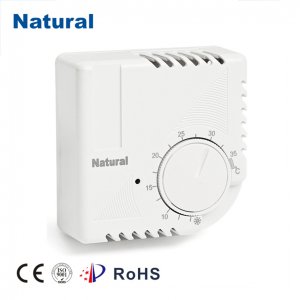In our modern world, we often take for granted the comfort and convenience of controlling the temperature in our homes with the flip of a switch or the push of a button. It’s an invention that has revolutionized our lives, and it goes by the name of the adjustable thermostat. In this article, we will explore the history, technology, and impact of this ingenious device.

The Birth of a Game-Changer The adjustable thermostat, a device that allows us to regulate the temperature of our living spaces, has a fascinating history that dates back to the early 19th century. Before its invention, maintaining a comfortable indoor climate was a challenging task. People had to rely on manually adjusting dampers, opening windows, or using bulky and inefficient heating stoves. These methods were not only cumbersome but also often resulted in discomfort and wasted energy. The breakthrough came in 1883 when Warren S. Johnson, an American inventor, introduced the first practical thermostat. His invention, known as the “Johnson System,” employed a bimetallic coil that expanded and contracted with temperature changes, thus opening or closing a circuit to control heating and cooling systems. This marked the beginning of a new era in home comfort. Evolution of Technology Over the years, thermostats have evolved significantly. From the early bimetallic designs to the electromechanical thermostats of the mid-20th century, and finally to the digital and smart thermostats of today, the technology has come a long way. Electromechanical thermostats, which dominated the market for many years, used a mercury switch to control the temperature. However, these thermostats had several drawbacks, including the use of toxic mercury and limited accuracy. The digital revolution in the late 20th century brought about programmable thermostats, allowing homeowners to set schedules for heating and cooling. This innovation not only enhanced comfort but also led to energy savings by reducing heating and cooling when not needed. In recent years, smart thermostats have taken center stage. These devices connect to Wi-Fi networks, enabling remote control via smartphone apps and integration with smart home systems. They use advanced algorithms to learn user preferences and adjust temperatures accordingly, maximizing energy efficiency and comfort. Energy Efficiency and Environmental Impact The adjustable thermostat has had a profound impact on energy consumption and the environment. By allowing precise control of heating and cooling systems, it has helped reduce energy waste and lower utility bills. Programmable and smart thermostats, in particular, have played a crucial role in promoting energy efficiency. Moreover, as the world becomes more conscious of environmental issues, the thermostat’s role in reducing carbon emissions cannot be overlooked. Efficient temperature control means fewer greenhouse gas emissions, making it an essential tool in the fight against climate change. Challenges and Future Prospects Despite the advancements in thermostat technology, there are still challenges to overcome. One of the primary concerns is the disposal of old thermostats containing mercury, which poses environmental risks. Additionally, the proliferation of smart thermostats has raised privacy and cybersecurity concerns. Looking ahead, the future of thermostats appears promising. We can expect further innovations in energy-efficient algorithms, enhanced integration with renewable energy sources, and increased connectivity with other smart devices in our homes. These developments will not only make our lives more comfortable but also contribute to a sustainable and eco-friendly future. Conclusion The adjustable thermostat is a testament to human ingenuity and innovation. From its humble beginnings in the 19th century to the sophisticated smart thermostats of today, this invention has transformed the way we control the temperature in our homes. It has made our lives more comfortable, saved energy, and contributed to environmental sustainability. As we continue to advance in technology, we can look forward to even more intelligent and eco-friendly solutions for managing our indoor climate.